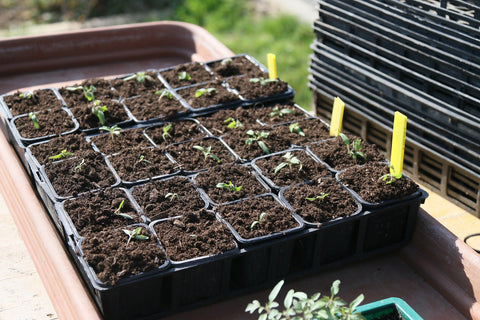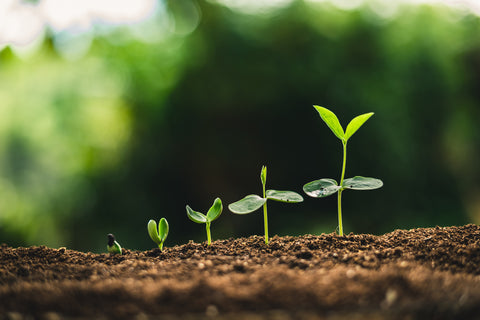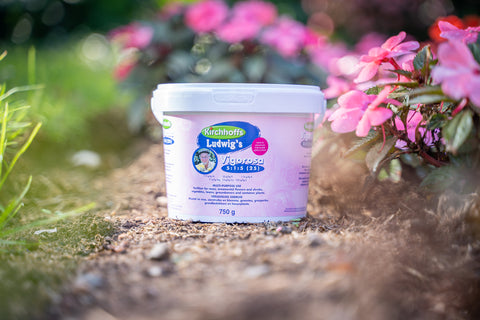Vegetable seeds to Flower seeds - how best to prepare to sow and grow your seeds!
Whether you are a novice or expert gardener, when you start a flower, vegetable or herb plant from seed, there are basic steps to take to ensure success.
To start off, remember that our seed comes packaged in a resealable foil pack so there is no need to use it all at once. As long as you store it correctly, you can keep the seed fresh in the sealed package for up to 2 years. Be sure to store the seeds in a cool, dark area that is dry to ensure longevity of the seed.

When sowing seed, always use sterile germination mix or seedling starter for germination. This prevents any contamination of other plants that were planted in the soil the previous year. The benefits of this are to ensure nutritious soil for the seed as well as no pre-existing pests or diseases in the soil. After all, healthy plant will produce the most vibrant flowers and delicious vegetables.
Sow the seeds evenly into a sowing tray with individual cavity cells. This way you can more closely monitor the germination and move the seedlings according to weather conditions.
For best and quickest germination results, place the sown seeds in a warm area with slight humidity and sunlight. This will prevent the soil from drying out without encouraging fungus or diseases by allowing airflow through the seedlings. It is best not to place seeds in direct sun, as the seed can be delicate and dry out or burn in harsh sunlight.

Depending on the variety, seeds can take anywhere from 7 to 28 days to germinate. Be sure to maintain moisture during this period and if possible, maintain temperatures as much as possible. Big fluctuations in temperature, from cold evening temperatures to sweltering daytime temperatures, can severely stunt germination. Avoid temperature fluctuations by bringing seedlings indoors in the evenings, especially in cooler areas.
Once the seedlings have developed at least four true leaves, you can start the hardening off process. True leaves are identified as adult looking leaves, whereas cotyledon leaves do not show the characteristics of the leaves of the mature plant.
True leaves usually show a few weeks after germination, depending on the variety and growing conditions. True leaves are the leaves that can perform photosynthesis and generate and provide food for the plant upon transplanting.

During the hardening off period, start preparing your garden bed or container soil for transplanting. Ensure that the soil is loose to a depth of double the root ball size and the same width. A slow-release pelleted fertilizer would work well to mix into the soil before transplanting the plug (young seedling).
Hardening off is the process that slowly introduces young seedlings to the outside elements of wind, sun, cool and warm conditions.
We recommend the following process:
- For the first few days, place the seedlings in a warm sunny area for a brief period of 30 minutes.
- It is best to start this in the morning hours to prevent the harsh afternoon sun until the seedlings are stronger.
- Slowly increase the period outside in increments of 30 minutes.
- When the seedlings do not show signs of drying out/wilting or sunburn from being outside, you can increase the time to an hour at a time.
- When your seedlings appear strong, they can move into the garden.
Before you transplant your seedlings into the garden – be sure to give the area a thorough watering. Using a watering can allows you to provide localised water directly to the area and prevent wasteful water usage.
We have a sneaky trick for you – place a small amount of slow release fertiliser, such as Ludwigs Vigarosa, in the hole and water the area before you transplant. This is helpful as it loosens the soil as well as provides water and nutrients directly under the roots, encouraging the roots to grow down strong.

Your plant should be settled and the roots extending in about a week or two. During this time period, don't allow the soil to dry out, however it isn't necessary to water every day or even every second day. Do the finger test – a simple method used to detect the moisture of the soil. Stick your finger into the soil, a few centimeters beneath the surface. If the soil is dry, it’s a good time to water, if you feel moisture, hold off for another day or two. It’s that simple!
We hope these tips help, but please feel free to consult each variety on our online store for more growing information.
With these basic guidelines and the help of our experts, we aim to provide each of our customers with the tools to grow a flourishing garden.


1 comment
Thankyou for the excellent advice !